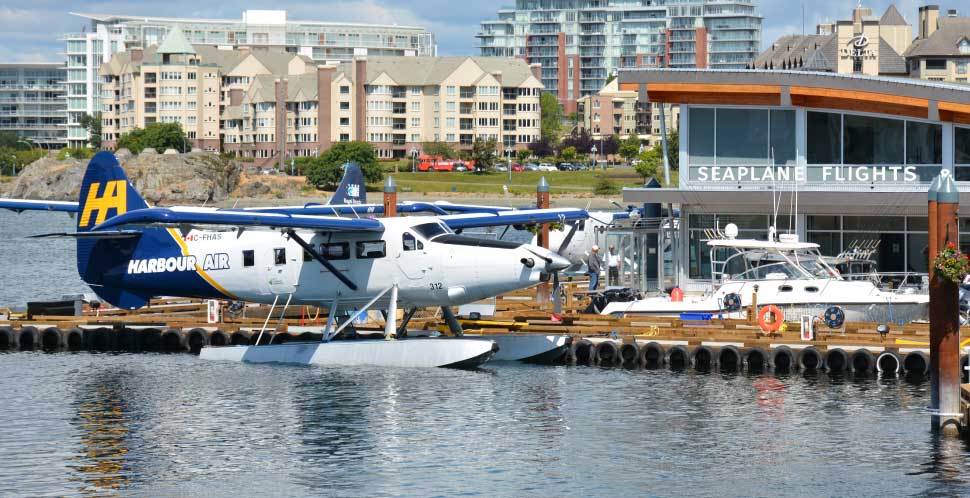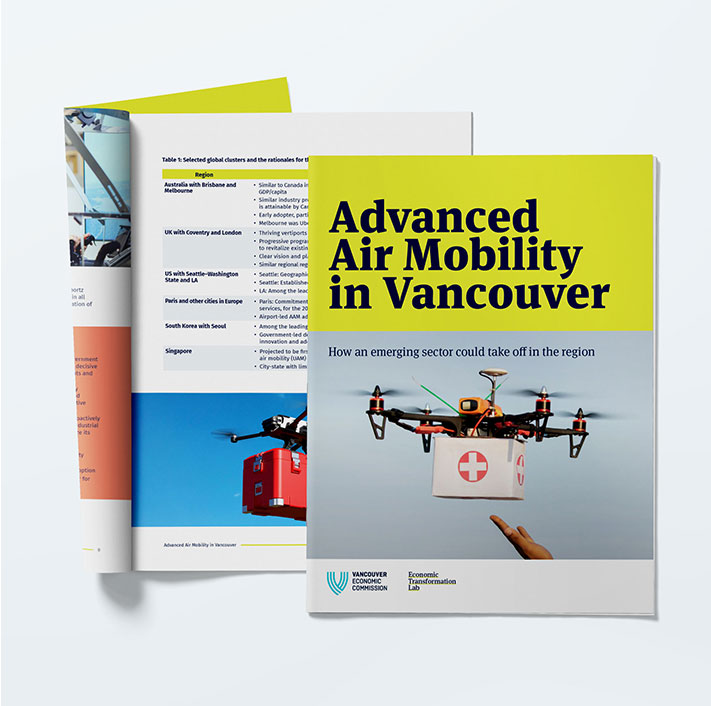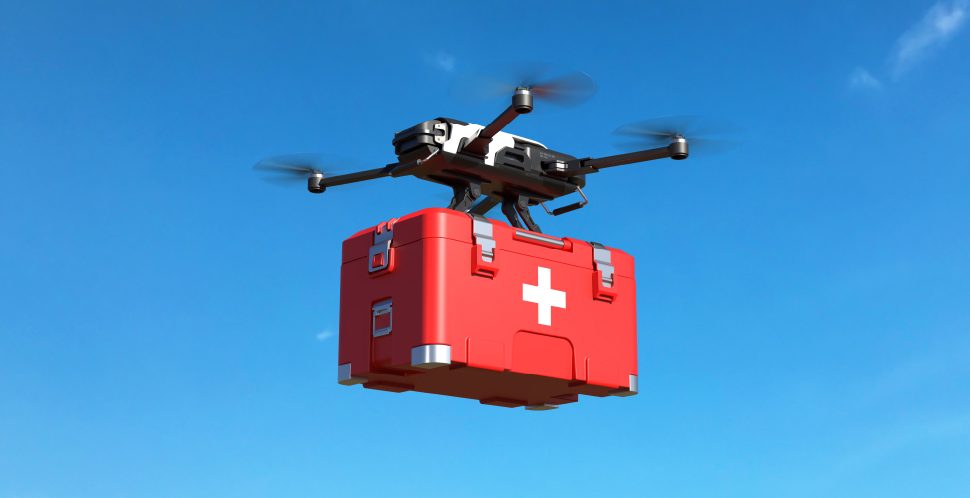It’s easy to recognize the important role that aviation plays in Vancouver
Canada Place in downtown Vancouver is flanked by two aircraft bases: Vancouver Harbour Heliport, home to Helijet; and Vancouver Harbour Flight Centre, the main base of Harbour Air – the largest seaplane operator in North America, and a carbon-neutral aviation company. Several companies, including, SKY Helicopters and Sea to Sky Air, offer flightseeing excursions showcasing the natural beauty of Vancouver and surrounding regions.
Moreover, the Vancouver region is an international hub for multi-modal transportation and trade. Vancouver International Airport (YVR), one of the busiest airports in North America, was named the continent’s top airport for more than a decade. Moreover, it is Canada’s second-busiest airport in terms of passengers and cargo weight received. Over 302,000 tonnes of cargo and 19 million passengers were transported through YVR in 2022.
Furthermore, YVR is the site of the world’s first-ever commercial electric flight, operated by Harbour Air and MagniX, and the Metro Vancouver base for Iskwew Air, an Indigenous-owned and operated airline connecting Vancouver Island and the Lower Mainland.
With such a strong stake in the aviation industry, it’s only natural for Vancouver to serve as a pilot city for the next evolution of flight.
What is Advanced Air Mobility (AAM)?
Advanced Air Mobility (AAM) refers to transformative airborne technology that transports people and goods in new, socially responsible ways, using cost-effective aircraft in rural and urban environments. Specifically, AAM builds upon electric battery and hydrogen fuel cell technologies to create aircraft and autonomous drones that operate with zero emissions.
AAM encompasses both non-passenger and passenger air mobility (PAM). Non-passenger systems are typically in the form of remotely piloted aircraft systems, or drones, and are mainly used for goods delivery (including medicine and packages), monitoring or inspection. PAM uses electric aircraft to transport people, including for ambulatory purposes where traffic congestion can slow ground-level rescue services.
As an emerging sector, and as an industry subject to the safety, liability and regulatory considerations common to transportation and airspace, advanced air mobility must navigate numerous policy challenges. Many applications require a significant degree of public acceptance and social license. As such, building clear alignment and vision between industry, public engagement, governments, and other regulatory bodies is a priority in every place considering its deployment.
The AAM ecosystem in Vancouver
Vancouver’s AAM development is supported by its strengths in complementary clusters: conventional aircraft and port operators; hydrogen power systems; agritech; and aerospace manufacturing. BC has the third largest aerospace cluster in Canada; it’s also part of the Cascadia region, which includes AAM’s third most competitive US state cluster, Washington State.
Vancouver is home to a thriving drone cluster, which includes companies supplying drones, counter-drones, and drone navigation. There are also companies providing operations-specific remote monitoring services and support to the real estate, construction, agriculture, industrial and film sectors.
Drones are increasingly being deployed in response to natural disasters, such as wildfire management and landslide risk assessment – issues that are becoming more prevalent due to climate change.
Existing Vancouver aerospace operators – including Helijet, Harbour Air and YVR – are key players that have expressed support for AAM and are able to both benefit from and facilitate its deployment. Helijet, Harbour Air and other local businesses, government and academic institutions are members of the Canadian Advanced Air Mobility (CAAM) consortium, which serves as a national catalyst for the AAM industry in Canada.

Photo by Gary Tou on Unsplash
However, the scaling of uncrewed aircraft systems and passenger air mobility is only likely to happen after 2030 would require extremely strong support by both communities and governments.
Lastly, from a systems view, the most net-positive and high-value AAM applications are those that do not already supplant existing net-zero transportation services or initiatives, such as routine ground-level delivery (i.e. not medical or otherwise life-saving supplies), or public transit.
Benefits of adopting AAM in Vancouver and BC
AAM applications could support decarbonization of the aviation industry while fulfilling some of the net-zero ambitions set by industry and all orders of government. Moreover, electrified planes are comparatively quieter than existing flights by helicopters and seaplanes, which can result in significant reductions to local noise pollution.
There are many potential ancillary benefits to AAM in the Vancouver region and BC more broadly. One is improving the speed and access of emergency response and healthcare, with AAM aircraft providing support to Medivac and medical supplies delivery.
For instance, in 2021, UBC and Drone Delivery Canada began their Remote Communities Drone Transportation Initiative, which transported medical supplies and PPE to the relatively isolated Stellat’en First Nation.
Another is exploring its applications in sustainable or remote tourism; in Vancouver, that can mean building upon an existing reputation as a sustainable travel destination by offering low-carbon aerial tours of natural landscapes across BC. Subject to the active participation of Indigenous-led tourism associations and travel services, it could even provide an additional option for economic self-determination among British Columbia’s more remote First Nations and other Indigenous communities.
The potential economic opportunities of AAM include spending and job creation related to research, commercialization, and deployment. Developments in AAM could also dovetail well with BC’s hydrogen and aerospace maintenance, repair and overhaul, manufacturing and telecommunications clusters.
AAM around the world
Global momentum for AAM is building quickly. The PAM sector attracted CA$9.1 billion in new investment in 2021, out of a total CA$16.7 billion since 2010. PAM is expected to start operating in 2024 in France, Singapore and the UK, followed by Japan and South Korea in 2025.
Meanwhile, drone operations are already well-established in many parts of the world. Two companies have announced plans to establish remote command centres for their global operations in 2022: Swoop Aero in Melbourne, Australia and Skyports at the Westcott Space Cluster in the UK.
In Canada, Edmonton International Airport has emerged as a leader in the implementation of remotely piloted aircraft (RPAS) operations. It also holds distinction as the first airport in Canada to fully operate commercial drone delivery services. Dymond Group, a major investor of Urban-Air Port – one of the world’s most recognized startups for vertiports, or areas designed specifically for AAM aircraft to take off and land – has plans to open two vertihubs in Canada. And Quebec received a boost for AAM development with an aircraft purchase agreement between Jaunt Air Mobility and Vertiko Mobilité, with flight operations targeted for 2026.
AAM demonstrations at world events
Many AAM leaders are incorporating AAM demonstrations into global events. This approach serves as an attractive value proposition and policy commitment for investors, which could reduce the need for direct government funding.
An example is the 2010 Vancouver Winter Olympic and Paralympic Games, during which Ballard demonstrated its vehicle hydrogen fuel cell systems. Upcoming events where AAM developments can be demonstrated include the 2024 Summer Olympics in Paris, France; Expo 2025 in Osaka, Japan; and FIFA World Cup 2026 in Vancouver, Canada.
The future of AAM in Vancouver
Through its Economic Transformation Lab initiative (ETL), the Vancouver Economic Commission supported a UBC research team-led survey of the local and global AAM landscape, pairing it with insights from the local ecosystem, many of whom were consulted through their affiliation with the Canadian Advanced Air Mobility (CAAM), an industry–government consortium exploring the deployment of advanced air mobility in the country. The team compiled its findings in a report called Advanced Air Mobility in Vancouver. The report proposes solutions to further develop Vancouver’s AAM clusters, with an emphasis of delivering economic, environmental and social benefits locally.
It should be noted that the team did not conduct a cost-benefit analysis of adopting AAM in the region, and does not include a quantification of economic benefit. As such, the Vancouver Economic Commission focuses not on the question of whether the AAM sector should scale, and instead on the competitiveness and promise of the Vancouver region and BC as a site for AAM deployment.
The report outlines a roadmap for catalyzing the adoption of AAM in Vancouver. Steps include formulating an AAM vision, building public trust and community engagement, and building on existing studies and initiatives.

Advanced Air Mobility in Vancouver
Access your free copy of the report to learn more about AAM in Vancouver and around the world



